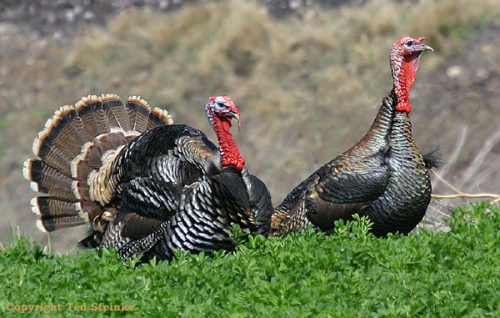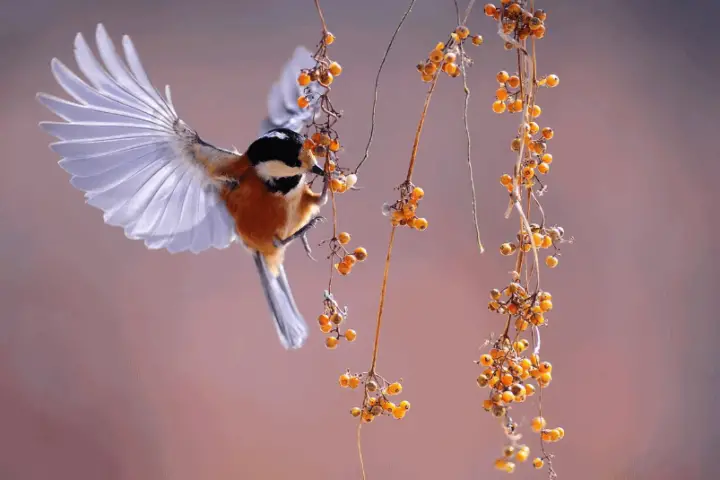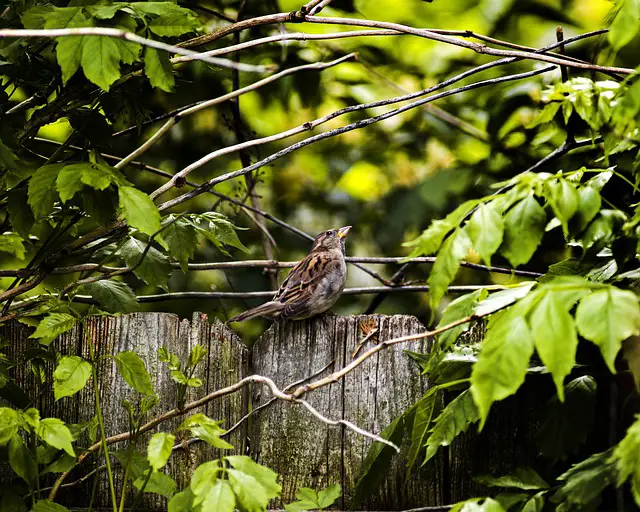The wild turkey (Meleagris gallopavo) is a native bird of North America. It makes home in a variety of habitats. The bird is the largest native gallinaceous bird discovered by the European immigrants. Hunting reduced the population of wild turkey to the lowest numbers by the end of the 19th century.
Wild Turkey Facts
Anatomy
- The adult male turkeys are 100–125 cm (39–49 in) long and weighs up to 5 to 11 kg (11 to 24 lb).
- Female turkeys weigh around 2.5–5.4 kg (5.5–11.9 lb) and averages 76 to 95 cm (30 to 37 in) in length.
- The length of the wings is up to 1.25 to 1.44 m (4 ft 1 in to 4 ft 9 in) while the wing chord measures 20 to 21.4 cm (7.9 to 8.4 in) in length.
- Wild turkeys have 2 to 3.2 cm (0.79 to 1.26 in) long bill whereas the tarsus measures 9.7 to 19.1 cm (3.8 to 7.5 in) in length.
- The length of the tail is 24.5 to 50.5 cm (9.6 to 19.9 in).
- Adult wild turkeys are recognized by their long reddish-yellow legs. The overall color of the body feathers is black.
- Adult males are known as toms or gobblers.
- While young turkeys are called jakes females are called hens.
- There are around 5,000 – 6,000 feathers on wild turkey’s body.

Habitat
- Wild turkeys fancy living in conifer-hardwood forests such as seasonal marshes, fields, orchard, and pastures.
- They will occupy almost any habitat that offers dense plants provided the openings are widely available.
- In the Northeast of North America, wild turkeys are most likely to breed in the red oak forests, white ash forests, cherry forests, beech forests as well as in the timber of oak-hickory.
- Their habitat also includes farms, plantations, and clearings, along with the principal rivers and swamps.
Behavior
- Unlike domestic turkeys, wild turkeys take extremely agile flight even though they are heavier.
- Woodland grasslands or open woodlands are ideal habitats for these birds in which they may fly under the canopy top.
- Wild turkeys typically fly just above the ground for up to 400 meters.
- They have a range of vocalizations such as purrs, yelps, cutts, whines, cackles, gobbles, clucks, putts, and kee-kees. Their voices can heard at a distance of a mile.
Feeding Ecology & Diet
- Like most other birds, wild turkeys have omnivorous diet. They will feed either on the ground or on small trees.
- Wild turkeys seem to eat nuts, acorns, chestnut, pinyon pine, hickory, berries, bearberry, seeds, juniper, insects, and roots.
- They rarely feed on small reptiles including snakes or lizards and amphibians.
- Wild turkeys supplement their with a variety of grasses.
- They are thought to gather around in large numbers because they go for many different types of food.
Predators
- Wild turkeys have many different potential predators—from small carnivorous land mammals to large birds of prey. Some will eat the young while other prey on adults, still others consume turkey’s eggs.
- Land mammals include grey foxes, Virginia possums, striped skunks, raccoons, bobcats, gray wolf, American black bears, cougars, domestic dogs, spotted skunks, and ground hogs. Wild turkeys also get killed by rodents.
- Snakes are known to eat turkey’s eggs. These include gopher snakes, pinesnakes, and rat snakes.
- Predators also include birds of prey such as bald eagles, golden eagles, barred owls, red-shouldered owls, red-tailed eagle, broad-winged hawk, and Cooper’s hawk.
Reproductive Biology
- Male turkeys are polygamous and will make as many partners as it can in a lifetime.
- The male will drag its wings often spread out its tail or even puff out feathers to attract the attention of a female. This behavior is known as strutting.
- Wild turkey can change the color of its head or neck depends on its mood.
- The males display courtship behavior in the months of March and April.
- They are often seen courting in large groups.
- Females lay up to 10 – 14 eggs. She lays one egg each day.
- The incubation period lasts about 28 days.





